Secure attachment fosters trust and comfort in seeking closeness, while avoidant attachment leads to emotional distance and reluctance to pursue proximity. Discover how these contrasting patterns impact relationship dynamics in this article.
Table of Comparison
| Aspect | Secure Attachment | Avoidant Attachment (Proximity Seeking) |
|---|---|---|
| Proximity Seeking | Seeks closeness and comfort when distressed | Avoids closeness, suppresses desire for comfort |
| Trust | High trust in caregiver's availability | Low trust, expects rejection or unavailability |
| Emotional Expression | Open and clear communication of needs | Restricts expression, maintains emotional distance |
| Response to Stress | Seeks support, calms effectively with help | Withdraws, relies on self-soothing |
| Attachment Behavior | Balanced seeking and exploration | Suppresses attachment needs, emphasizes independence |
Understanding Attachment Styles: Secure vs Avoidant
Understanding attachment styles involves recognizing Secure attachment as characterized by comfort with intimacy and effective proximity seeking during stress, promoting healthy emotional bonds. In contrast, Avoidant attachment reflects discomfort with closeness and a tendency to minimize proximity seeking, often resulting in emotional distance and self-reliance. These distinct behaviors influence relationship dynamics, where Secure individuals seek support and Avoidant individuals prioritize independence under stress.
Defining Proximity Seeking in Relationships
Proximity seeking in relationships refers to the innate desire to be physically or emotionally close to a significant other, crucial for establishing security and attachment. Secure individuals seek proximity as a natural expression of trust and comfort, whereas avoidant individuals often resist closeness, perceiving it as a threat to their independence. Understanding these variations helps clarify how attachment styles influence the ways people pursue or avoid intimacy in relationships.
Core Characteristics of Secure Attachment
Secure attachment is characterized by comfort with intimacy and trust in relationships, enabling you to seek support confidently and maintain emotional balance. Core characteristics include reliable emotional availability, effective communication, and resilience during stress, which contrasts with avoidant attachment's tendency to distance oneself from closeness. Proximity seeking in secure attachment involves approaching loved ones for comfort without fear of rejection, fostering healthy and stable relational bonds.
Key Traits of Avoidant Attachment
Avoidant attachment is characterized by discomfort with closeness, emotional distance, and a strong desire for independence, often leading to reluctance in seeking proximity or support from others. Individuals with avoidant attachment tend to suppress feelings and avoid intimacy to maintain control and self-reliance. This contrasts with secure attachment, where proximity seeking is balanced and comfort with closeness is achieved, and with anxious attachment, which involves intense proximity-seeking behaviors driven by fear of abandonment.
How Secure Individuals Seek Closeness
Secure individuals seek closeness by openly expressing their emotions and consistently relying on their partners for support, fostering trust and mutual understanding. They balance intimacy with autonomy, ensuring that their need for connection does not overwhelm their sense of self or their partner's independence. Your ability to communicate openly and respond sensitively strengthens emotional bonds, making proximity a source of comfort rather than anxiety.
Avoidant Behaviors and Proximity Resistance
Avoidant attachment behaviors are characterized by a strong resistance to proximity seeking, manifesting as discomfort with closeness and emotional intimacy in relationships. Individuals exhibiting avoidant patterns often distance themselves physically and emotionally to protect against perceived vulnerability, contrasting with secure attachment where proximity seeking is met with comfort and openness. This avoidance of closeness can lead to difficulties in forming stable, trusting connections due to persistent proximity resistance and emotional withdrawal.
Impact on Relationship Dynamics
Secure attachment fosters healthy relationship dynamics through open communication, trust, and emotional availability, promoting intimacy and long-term stability. Avoidant attachment, characterized by discomfort with closeness and emotional distance, often leads to challenges in expressing needs and maintaining connection, creating potential conflicts or relational dissatisfaction. Proximity seeking behaviors, especially in secure individuals, reinforce bonding and mutual support, whereas excessive or anxious proximity seeking in insecure types may trigger tension or avoidance responses, impacting overall relationship quality.
Communication Patterns: Secure vs Avoidant
Secure attachment communication patterns involve open, honest, and empathetic dialogue that fosters trust and emotional connection. Avoidant attachment, characterized by proximity seeking avoidance, often leads to indirect, distant, or minimal communication, hindering emotional intimacy. Your ability to recognize these patterns can improve relationship dynamics by promoting healthier, more secure interactions.
Navigating Conflict: Approaches by Each Style
Secure attachment individuals approach conflict with open communication, seeking resolution while maintaining emotional closeness and trust. Avoidant (Proximity Seeking) types tend to minimize emotional engagement, often withdrawing to maintain independence and reduce vulnerability during disagreements. Proximity seeking in general emphasizes the desire for closeness and reassurance, but styles vary, with secure seekers addressing conflict directly and avoidant seekers distancing themselves to manage discomfort.
Fostering Healthier Attachment and Connection
Secure attachment fosters your ability to seek comfort and connection while maintaining trust and emotional safety, promoting healthier relationships. In contrast, avoidant attachment leads to distancing behaviors during proximity seeking, often hindering emotional closeness and intimacy. Fostering healthier attachment involves recognizing these patterns to encourage open communication and more consistent emotional availability.

Infographic: Secure vs Avoidant (Proximity Seeking)
 relatioo.com
relatioo.com